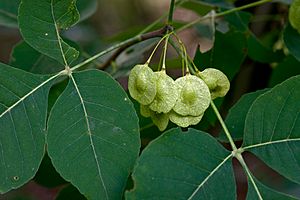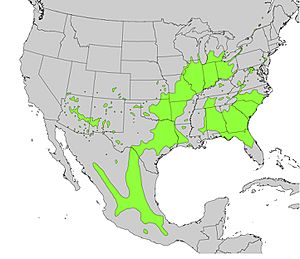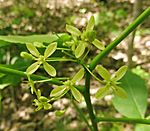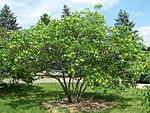Common hoptree facts for kids
Quick facts for kids Common hoptree |
|
|---|---|
 |
|
| Common hoptree fruit | |
| Conservation status | |
| Scientific classification | |
| Genus: |
Ptelea
|
| Species: |
trifoliata
|
 |
|
| Generalized natural range | |
| Synonyms | |
|
|
Ptelea trifoliata, often called the common hoptree, is a cool plant in the citrus family. It's also known as wafer ash or stinking ash because of its smell. This plant grows naturally in North America, including Canada, Mexico, and the United States. It's a deciduous shrub or small tree, which means it loses its leaves in the fall. Its leaves have three parts, like a clover.
Contents
What Does the Hoptree Look Like?
The common hoptree is usually a small tree or a shrub with several spreading stems. It can grow to be about 6 to 8 meters (20 to 26 feet) tall. It has a wide, rounded top.
Its bark is reddish-brown to gray-brown. It has small, warty bumps called lenticels. The plant often has a smell that some people find unpleasant. Its taste is bitter. The young branches are dark reddish-brown and shiny.
Leaves of the Hoptree
The hoptree's leaves grow in a special way. Each leaf is made up of three smaller leaflets. These leaflets have tiny oil glands, just like citrus fruits. They are about 8 to 13 cm (3 to 5 inches) long. They are pointed at both ends and can have smooth or slightly toothed edges.
When they first appear, the leaves are folded and fuzzy. As they grow, they become dark green and shiny on top. They are lighter green underneath. In the fall, they turn a pretty rusty yellow color. The leaves of hoptrees in drier western areas are smaller than those in the east.
Hoptree Flowers
The hoptree's flowers are small, about 1 to 2 cm (0.4 to 0.8 inches) wide. They have 4 or 5 narrow, greenish-white petals. These flowers grow in clusters at the ends of the branches.
They bloom in May and June. Some people don't like the smell of the flowers, but others think they smell wonderful!
Hoptree Fruit
The fruit of the hoptree looks like a flat, round paper wafer. It is about 2 to 2.5 cm (0.8 to 1 inch) across. It's light brown and usually has two seeds inside. The fruit ripens in October. It stays on the tree until strong winds blow it off in early winter.
Hoptree Wood
The wood of the hoptree is yellowish-brown. It is heavy, hard, and has a smooth, satiny feel.
Gallery
Hoptree Types and Names
Ptelea trifoliata is often seen as one main type of plant. But there are also different kinds, like subspecies and varieties, that grow in different places. Some scientists even think these different kinds might be separate species.
The name "trifoliata" means "three-leaved." This refers to the hoptree's leaves, which have three parts.
This plant has many other common names too! Some of them are stinking prairie bush, Carolina shrub-trefoil, tree-trefoil, swamp dogwood, ague bark, quinine tree, and water-ash.
Where Does the Hoptree Grow?
The common hoptree grows naturally across North America. You can find it in Canada, especially in Ontario and Quebec. It also grows in many parts of the eastern and southwestern United States. You might not see it in some areas of the Upper Midwest or much of New England. Its range extends south into Mexico.
It can live in many different places. In the southeastern U.S., it often grows in rocky forests. It likes both wet and dry soil, especially where the ground has certain types of rocks. In the Midwest, it lives in forests, open grasslands called savannas, prairies, and even sand dunes. In Arizona, it is common in canyons.
Who Likes the Hoptree?
The hoptree is important to many animals.
- The caterpillars of the giant swallowtail butterfly (Papilio cresphontes) love to eat its leaves.
- Small insects called treehoppers of the genus Enchenopa live on the branches. They lay foamy white egg masses there.
- Several types of ants, like the black carpenter ant (Camponotus pennsylvanicus), take care of these treehoppers.
- Many different bee species visit the hoptree's flowers. These include the honey bee (Apis mellifera) and several types of bumblebees and smaller bees.
How People Use the Hoptree
Native American groups have used the hoptree in many ways. They used it as a seasoning for food. They also used it as an herbal medicine to help with different sicknesses.
People also grow hoptrees in parks and gardens because they look nice. There are special types, called cultivars, that have been grown for this purpose. One type, 'Aurea', has pretty golden leaves and has won an award!
In the 1800s, German immigrants in Texas used the hoptree's seeds instead of hops when they made beer. This is how the plant got its common name, "hoptree."




